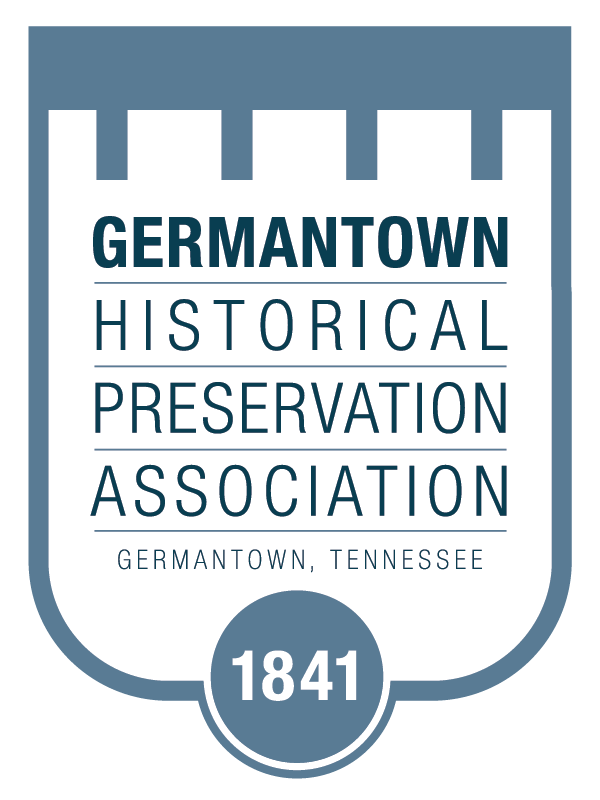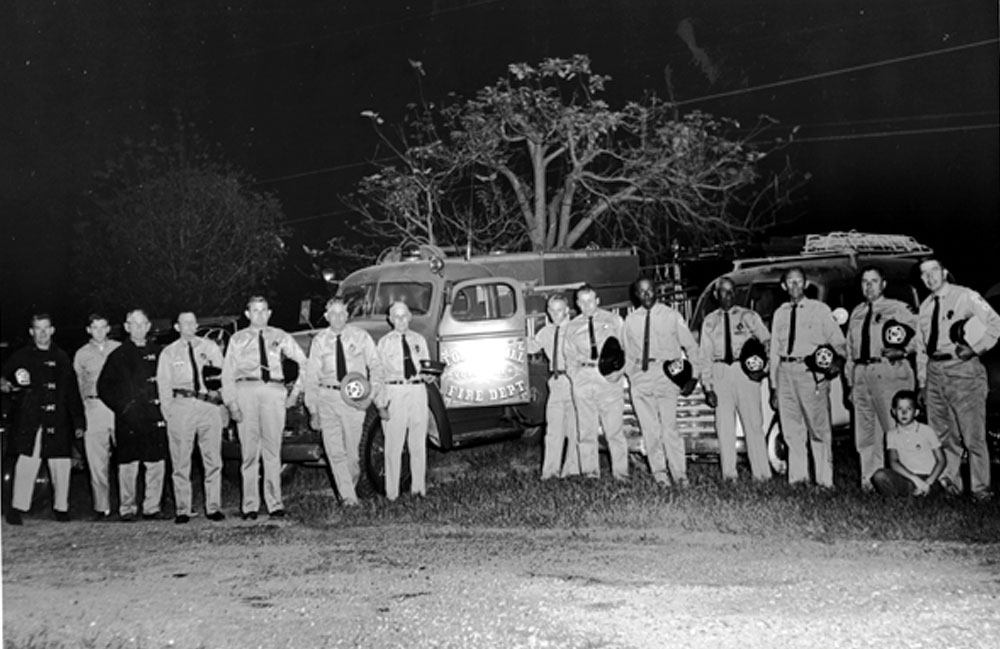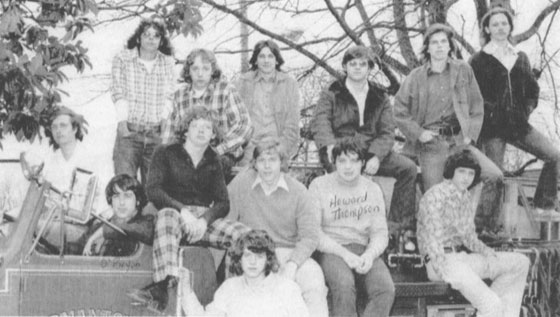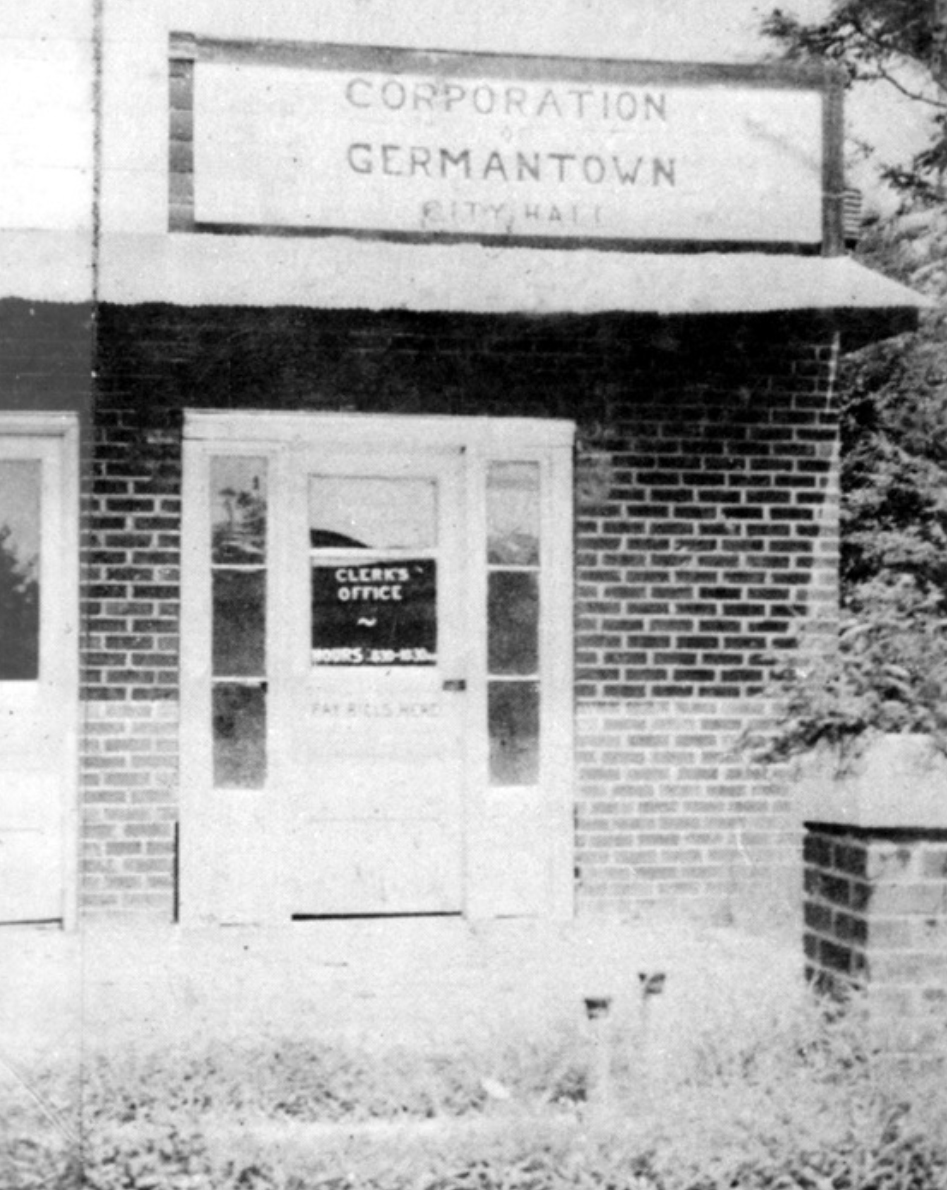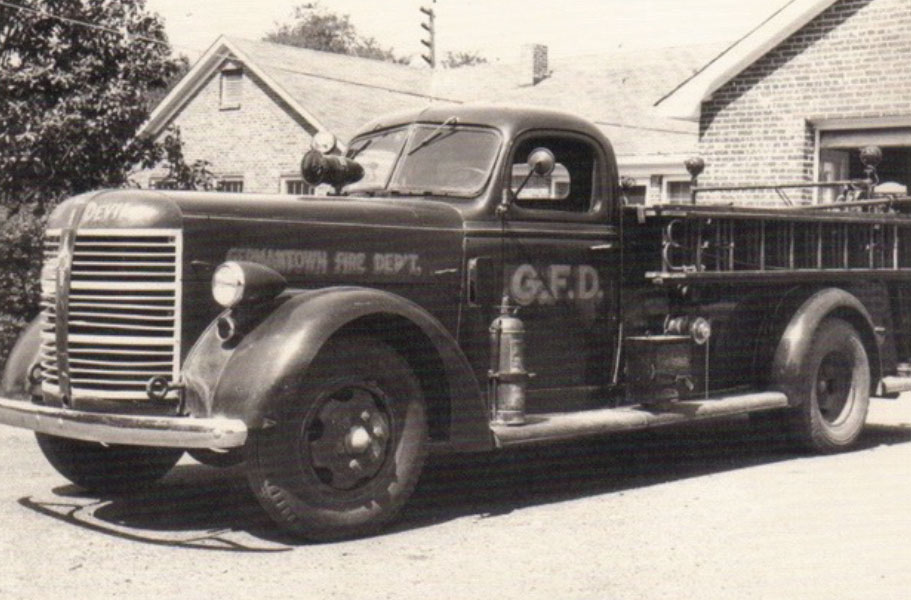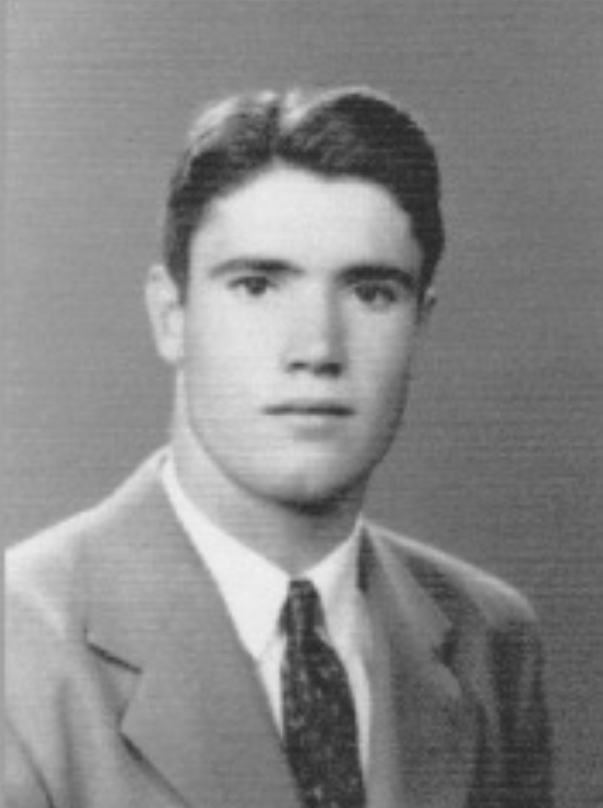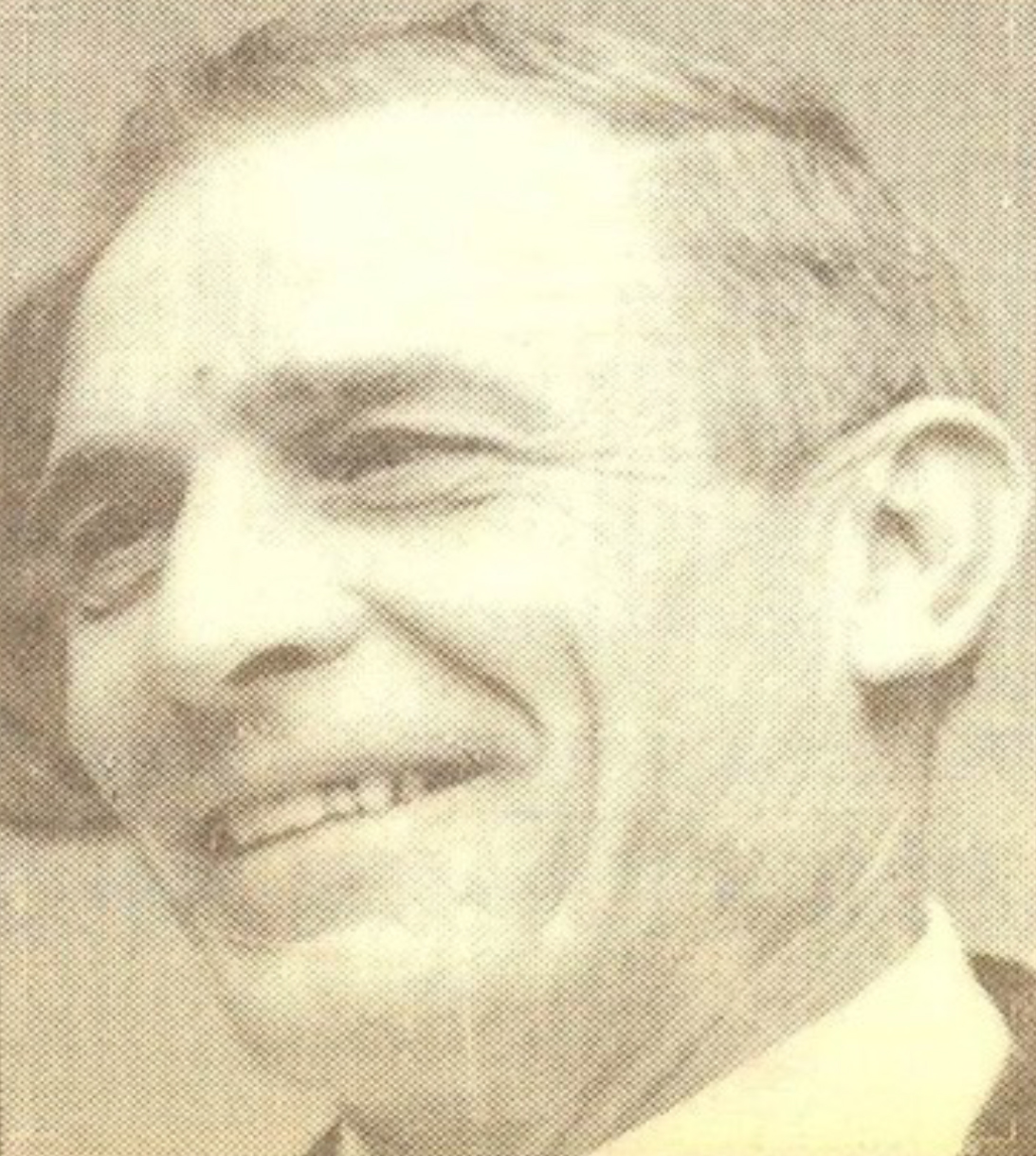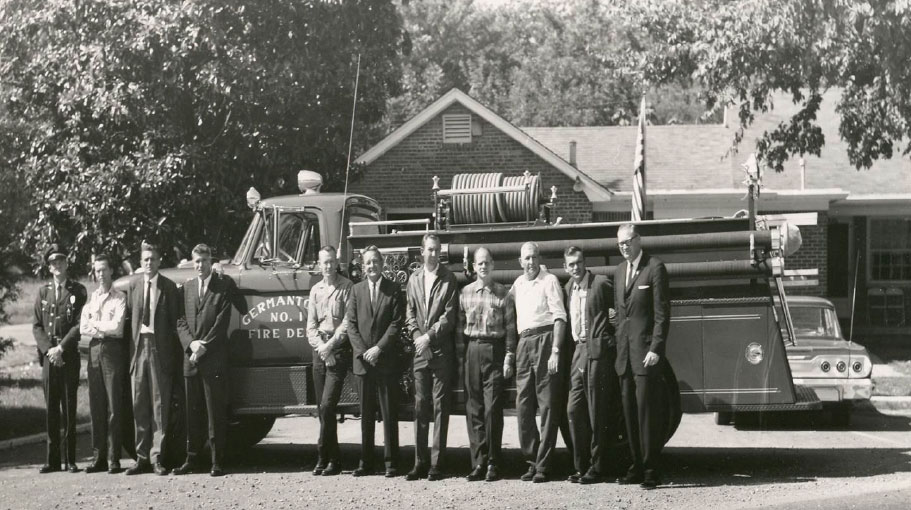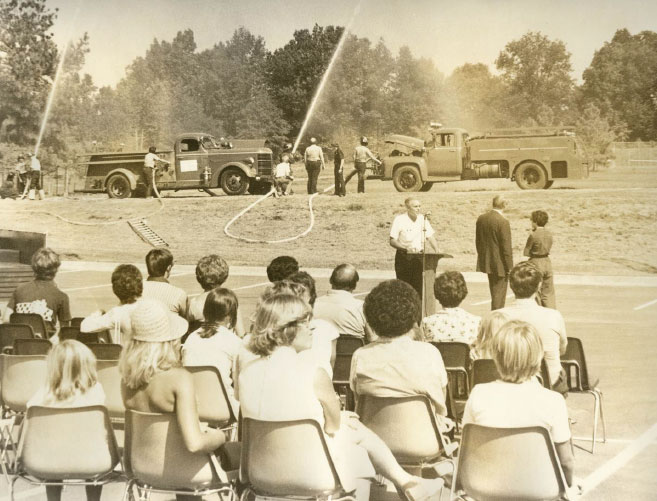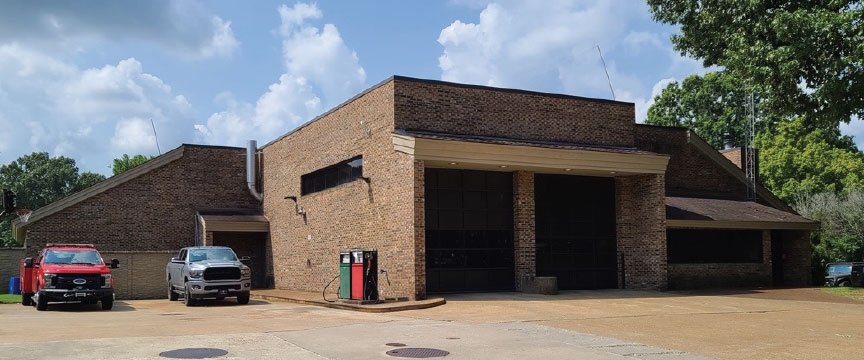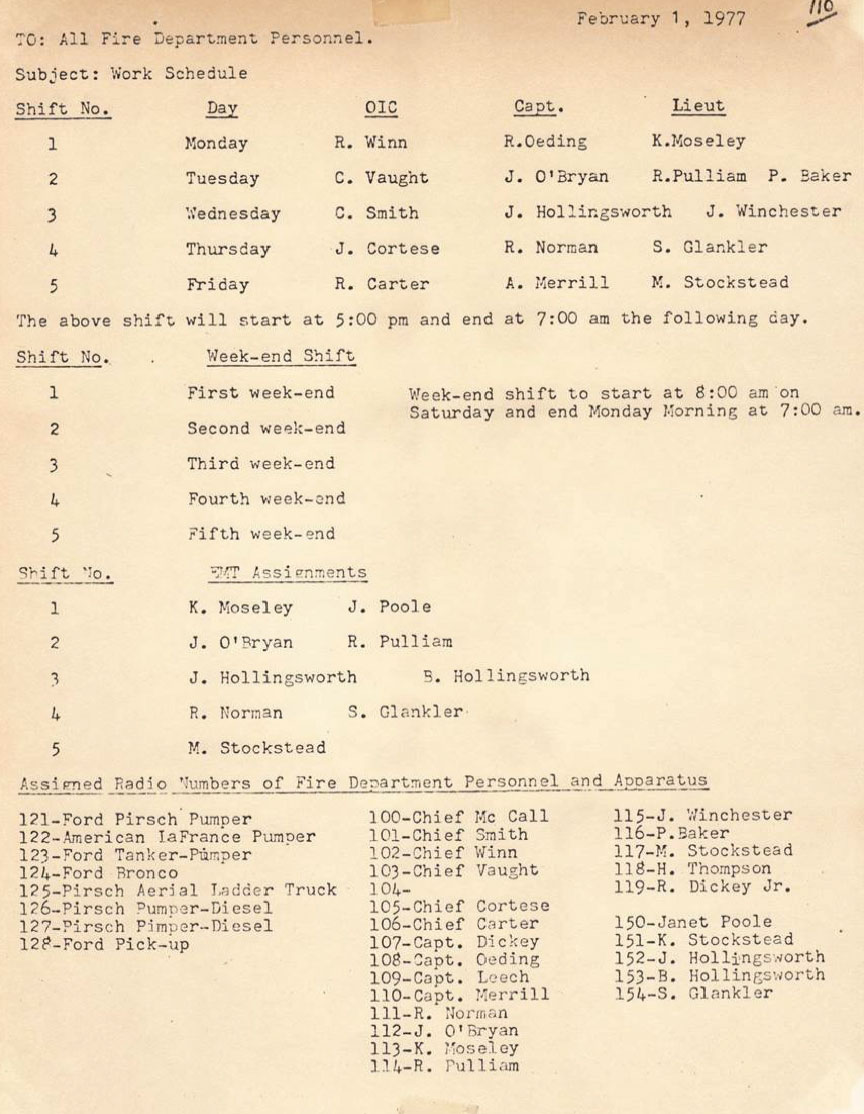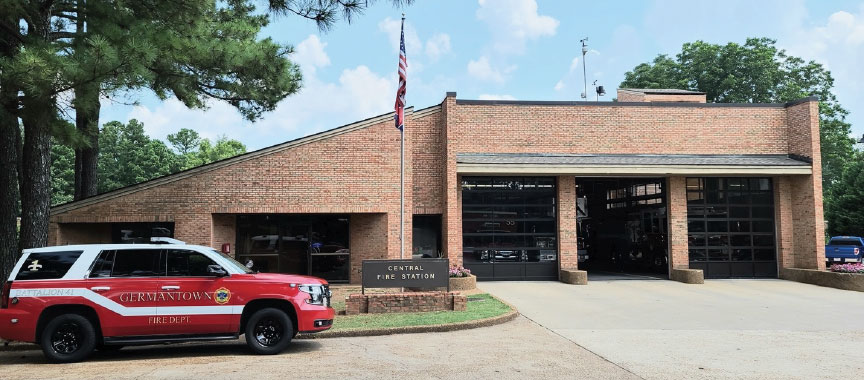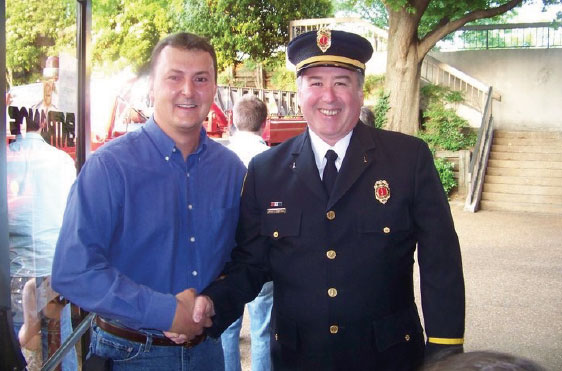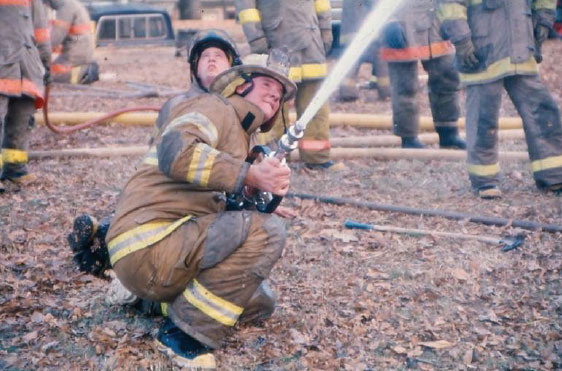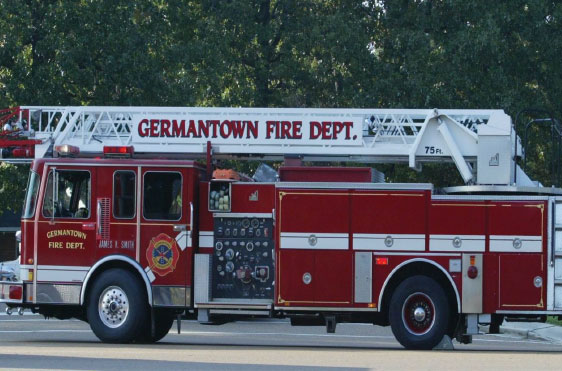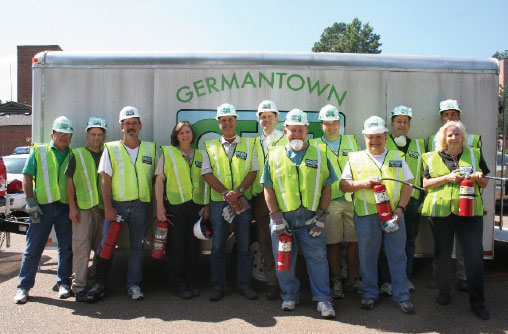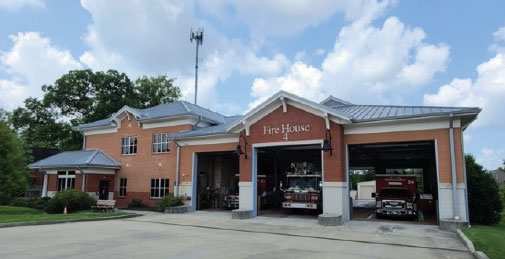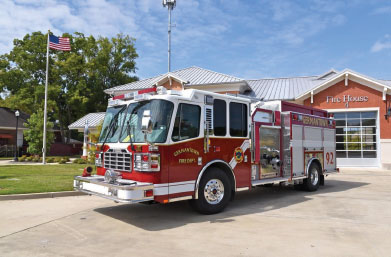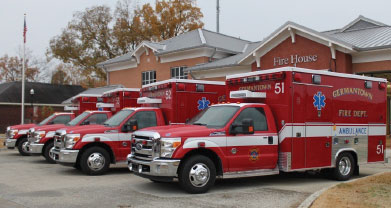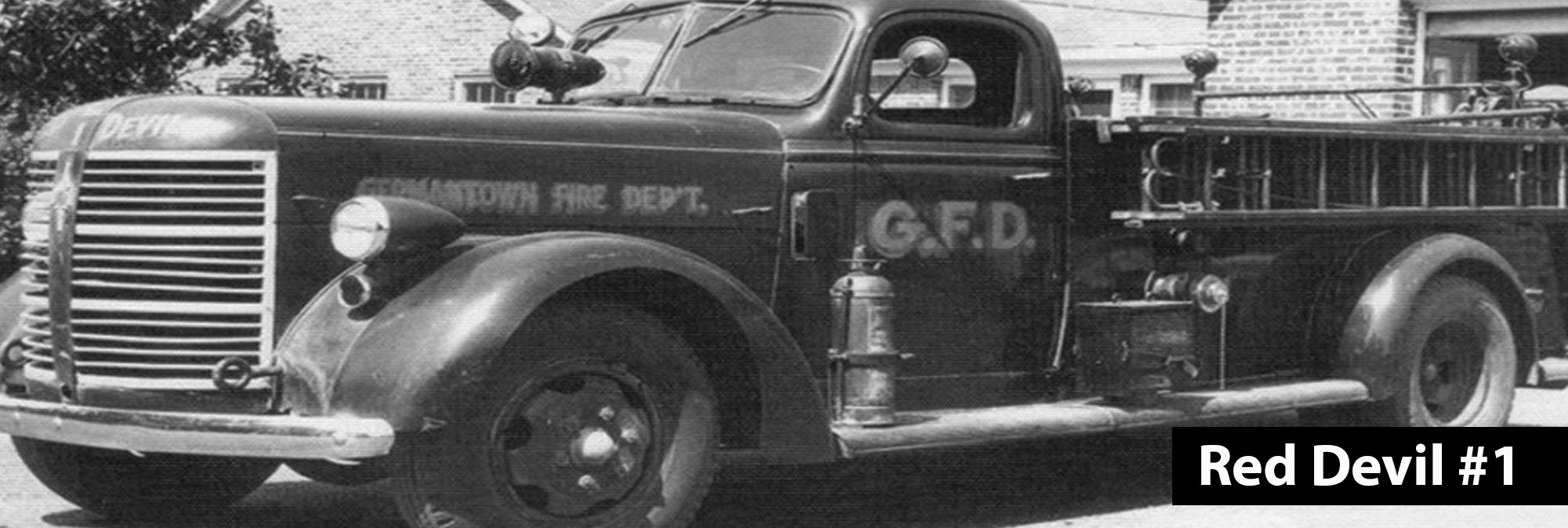
Fire Department
History from 1943-2011
1943 | 1945 | 1950 | 1960 | 1965 | 1970 | 1975 | 1980 | 1985 | 1990 | 1995 | 2000
2005 | 2010 | 2021
By Andrew Pouncey & Howard Thompson, Photos by Joe Lowry
1943
The Civic Club of Germantown held a meeting on April 8, 1943, to discuss the need for fire service. Mr. Arthur reported that they needed to form a fire department and discussed their needs. They stated that the W.P.B would make all the purchases and all that was needed was the funding. Mr. Miller suggested that a district for fire protection be set up. They agreed that the territory would also have areas outside the city.
On September 6, 1943, a committee from the Germantown Civic Club composed of George Chapman, W. D. May, Fred Beasley, and George Friedel met with the Mayor and Board of Aldermen to discuss post-war planning for the entire community. The object was to work out a definitive plan for an improved and up-to-date water system and fire protection service. The thought was that if they had a definite plan as to improvements desired, together with probable costs, etc., they would be in a more favorable position to be given the go-ahead immediately after the war, with perhaps federal aid which Mr. Friedel, who acted as spokesman, felt might then be available. Mr. Friedel suggested that the city contact Mr. C. M. McCord, Director of the Water Department of the City of Memphis, who would be able to help them with their expansion plan. It was also suggested in the meeting that Mr. Barry and Boyd Arthur form a committee to contact Mr. McCord and the others to determine the method, plan, and cost of the improved and extended water system. It was also decided that Mr. Boyd Arthur be authorized to locate the best type of fire equipment for their needs and report the costs so that the Board might proceed to inspect it.
On September 15, 1943, a special meeting of the Board was held to authorize the purchase of a new water pump, because the old one was worn out. The cost of the new pump was $1,050.00 installed. The pump was designed to deliver 150 gallons per minute.
1945
On September 3, 1945, a meeting was held with the Board to discuss the installation of the water mains, the water storage tank, purchase of the fire engine and related equipment, along with the acquisition of needed land and necessary labor and financing to complete the outline for water supply and fire protection as outlined in the Allen and Hoshall report, dated July 26, 1945. They also needed to obtain land for the installation of the six-inch water mains. They then looked into the reduction of insurance rates and the insurance class of 8. This would lower their rates by 30% for dwellings.
On February 6, 1946, the minutes for the September 3rd meeting were approved with a few amendments. A motion was made by S. E. Kidd and seconded by Stanley Law. The Corporation of Germantown promised and agreed to pay a loan made by the Union Planters National Bank and Trust Company of Memphis, Tennessee at the rate of $200.00 per month or more for the installation and purchase of water mains, an overhead tank, fire equipment, buildings, and land areas to comply with the Allen and Hoshall Report so that the Corporation of Germantown might attain a Class 8 fire protection rating. The mayor reported the purchase of the new 8″ and 6″ water mains, fire plugs, and fittings would be delivered in about 90 to 120 days by Crane Company of Memphis. At the same meeting, a vote of confidence was given to the Mayor, Boyd Arthur, and Aldermen acting as a committee to carry out plans for mains and installation, purchase of fire equipment, land, buildings, and other items.
Mayor Jack Barry and the Board of Aldermen realized the need for Germantown to have its own fire protection. Prior to this date, the City of Memphis had provided assistance from Fire Station 18 located at Southern and Ellsworth. At this time, the Germantown Fire Department was founded, and the city purchased a second-hand fire engine from Cordova Fireworks Plant.
The bill of sale for the vehicle was dated October 4, 1945, at a price of $6,452.64. The fire engine could pump 750 gallons per minute and carried 300 gallons of water. The American Lafrance fire engine was originally built in 1942 and delivered to National Fire Works, Inc. in Mays Landing, New Jersey. The fire engine was then moved to the Cordova, Tennessee plant prior to being purchased by the City of Germantown in 1945.
The fire engine was stored in a garage at the home of Fire Chief and Mayor Jack Barry, located on the northeast comer of Germantown and Dogwood. Noted Germantown historian Harry Cloyes remembers when Chief Barry would drive the engine out in front of the Barry home each day to keep the battery charged and to make sure the engine was in good running order. At this time, all citizens of the community of 300 residents were volunteer firefighters. The American Lafrance can1e equipped with 1,500 feet of 2-½” hose, 300 feet of 1-½” hose, and 400 feet of 3/4″ hose. It also had one 2-½” siamese, three 2-½” nozzles, one Pyrene fire extinguisher, one fast foam 3-gallon fire extinguisher, one Dugas 3-gallon fire extinguisher, one 24′ extension ladder, one strainer, four Indian pump cans for grass fires, one 2-½” fog nozzle, one siren and flasher, and two electric hand lamps.
In 1948, the city hall was built across from the railroad depot and the fire engine was housed there. When a fire alarm was received, a siren on top of city hall sounded alerting all volunteers of the call. The address was written on a blackboard on the front of the building so that responding firefighters knew where the fire was.
1950
In 1951, Fire Chief Anderson desired to be relieved of duties. Bobby Lanier at 21 years of age became Fire Chief and Roger Madison became Assistant Chief. Plectrons (radios tuned to the Germantown Fire Department’s radio frequency) were issued to a few members of the department. When a call was received, a special tone was set off, alerting the volunteers as to where the fire was. The members with Plectrons called four other members who did not have radios.
On January 5, 1956, the regular meeting of the Board was held, and they discussed the installation of new 6″ water lines that would go out to the highway. The work on these mains would start on February 3rd. Mr. O’Neal gave a report on a plan to organize and train volunteer firemen. His plan would train a more efficient fire department. It was decided that the department should not carry more than 26 men with a Fire Chief. This would allow men for both day and night duty. Each fireman would draw $1.00 for answering a fire call and up to one hour of service. He would be paid $1.00 per hour for as long as it is necessary to fight a fire. Each fireman would sign in and sign out on each call and fire equipment would be put in order before allowing firemen to sign out. The Chief would draw $2.00 per fire call and $2.00 for each hour thereafter. The Chief would be in charge of the men and his orders would be followed explicitly. In case of his absence, the Assistant Chief would have charge. There would be one meeting each month for drill and instructions, and each fireman who attended these monthly meetings would be paid $1.00 a meeting. A record would be kept by the secretary of time and hours served, and money would be paid out once a year. Should any member miss three meetings in a row he would be dropped from the roll of the fire department and would have to put on a waiting list if he wanted to rejoin the department. Any member with a medical problem or an employment issue would be excused. The estimated cost of this plan was $600.00 to $1,000 per year.
In 1956, Hugh Ford and John T. Carter built an 800-gallon tanker/pumper on a 1956 Ford Truck that was purchased for $2,150.00. This vehicle enabled the department to carry water to areas outside the hydrant district and pump water from lakes, ponds, and swimming pools. Also, in 1956, the department started collecting fire fees which supplemented the departmental budget. That year they had sent out 300 letters to people outside of the city. They had a total of 80 subscribers and an additional 25 people expressed interest. There were an additional 21 people who refused. This practice continued until 1970. In 1958, two army surplus Jeeps were purchased for use in fighting grass fires. In 1961, the department assisted firefighters from the Forest Hill, Collierville, and Capleville Fire Departments in fighting a grass fire 25 air-miles long. The grass fire started in Mississippi, spread into Tennessee, and required 500 inmates from the Penal Farm to contain the fire.
In October of 1959, Hugh Ford bought six sets of fire equipment from Joe Rape at a cost of $14.00 per helmet, coats without linings at $21.50 each, and coats with linings at$ 22.50 each. They also bought an unknown amount of boots at a cost of $237.00. This was probably around 12 pairs.
1960
On October 10, 1960, Mr. McCall advised that he had found an anonymous donor who would furnish the city with one base and three mobile two-way radio units to operate on a separate wave band. This donor would pay all expenses for securing the waveband and the license to operate. The only expenses the town would incur would be the cost of the installation which was estimated at about $250.00.
In February 1961, the pay rates for firefighters were changed. Third Class received $1.00 per hour for fires or meetings. Second Class received $1.25 per hour for fires and meetings. First Class firefighters received $1.50 per hour for fires and meetings. The Assistant Chiefs received $2.00 per hour for fires and meetings. The Chief and Secretary received $2.50 per hour for fires and meetings. A First-Class Fireman was one who could drive all apparatus and operate all equipment. A Second-Class Fireman was one who could do all operations except operate equipment. A Third-Class Fireman was a beginner on three months of probation.
In 1963, the population of Germantown was 1,500. Philip P. McCall was hired as the first paid employee of the Germantown Fire Department with the duties of Assistant Chief and Master Mechanic. The junior firemen’s program was started for young men ages 15 through 18 to be volunteer firefighters. These young men would go to the fire station after school. During weekdays, they would be called out of Germantown High School for fires, since adult members would be away at their jobs. Consequently, high school volunteers had to fight the fires. Otto Lyons was named the first Chief of the Junior Firemen. Otto would later become the Chief of the Bartlett Fire Department.
From December 1, 1964, until December 1, 1965, the Germantown Fire Department answered 9 house fires, 15 grass fires, 3 automobile fires, 2 school fires, 2 truck fires, 4 trash fires, 1 train accident, 1 barn fire, 2 false alarms, and 6 resuscitation calls. In 1965, the department purchased a Ford Pirsch 1,000 gallon-per-minute Class A pumper at a cost of $23,000. It carried 500 gallons of water and carried 1,200 feet of 2½” fire hose and had a pre-connect. With this pumper, the department was able to keep pace with the needs of a quickly growing community. In 1965, the average response time was about five minutes. In 1966, the department purchased a Ford Bronco to replace the two Jeeps being used for grass fires. The Bronco carried 60 gallons of water, a small pump, and a hose. The Bronco was replaced in 1987 with a Dodge brush truck. The current Ford brush truck was purchased in 1996 and carries 250 gallons of water.
1965
On March 3, 1967, companies responded to Germantown Road and Dexter on three men killed when an electrical wire fell. In 1967, the department made 50 mutual aid calls.
During a board meeting, a motion to reorganize the fire department was approved. Bobby Lanier was appointed Fire Chief. Philip McCall was appointed as Assistant Fire Chief or Instructor and Robert Howard was appointed Second Assistant Fire Chief. At the same meeting, Alderman Boldt made the suggestion that the city thinks about a location for a second Fire Station.
1970
In 1970, the department was starting to grow in an attempt to keep pace with the community. Assistant Chief McCall hired part-time Night Drivers to work in the evenings from 4:00 p.m. to 7:00 a.m. These were generally high school students that worked after school. There were 26 calls outside of the city, and the city billed for 8 of those calls. The dollar loss for the year was $31,725.
In 1971, the department responded to 143 calls.
On January 1, 1972, Chief Robert C. Lanier resigned as Fire Chief. Attributing his resignation to Germantown’s need for a full-time fire chief, he submitted the flowing letter to the Board:
“For the past eighteen years, I have been Chief of the Germantown Volunteer Fire Department. Due to my office being moved, I am not available now for the service which should be given to the community. I would like to submit my resignation to become effective the first of the year. Because of the growth of Germantown, I think the time has come when you should have a Chief on duty all the time, and I highly recommend that you appoint Phil McCall Fire Chief.” In February of 1972, Philip McCall was appointed full-time Fire Chief.
A second-hand 1954 Pirsch aerial truck was bought from Monroe, Wisconsin, and renovated. The aerial was 75 feet tall and could be used to place a stream of water in the tops of buildings, as well as for rescue purposes.
A motion was made by the Board to approve the part1c1pation in the County Fire Protection Plan. The County would provide fire protection for the County, necessitating the help of the Germantown Fire Department. The Germantown Fire Department would receive $15,000 for manpower and $15,000 for equipment.
The BMA gave direction to the fire department to contact the Tennessee Inspection Bureau to make a study for the location of the new fire station. In 1972, the department responded to 144 calls.
In 1973, Fire Chief Phil McCall suggested, and the motion was made and approved to adopt a Fire Code known as the Boca-Basic Fire Prevention Code.
The population of Germantown was now 6,500; two new 1,000 gallon-per-minute custom pumpers were purchased for a cost of $64,310.50 each. In 1973, the department responded to 250 calls.
In 1974, retired Memphis District Chief Charles E. Smith was hired as the Assistant Fire Chief. He served as Assistant Chief until 1979. His past experience helped the department grow alongside the community. Five full-time employees were hired in 1975. Also, during that year, many innovative changes occurred. Three firefighters attended Emergency Medical Technician training at Shelby State Community College; a pick-up truck was converted into a rescue vehicle, and the Germantown Fire Department was now in the rescue/E.M.S business. The department responded to 271 calls in 1974.
1975
On May 16, 1975, Unit 128 was placed in service as a rescue unit, increasing the department’s capability to carry additional rescue and medical equipment.
In July 1975, the Germantown Fire Department took delivery of two new Class ‘A’ Peter Pirsch 1,000 gallon-per-minute pumpers. Although only one engine was requested, the Board of Mayor and Aldermen, seeing the need for future growth, allowed for the purchase of the two pieces of apparatus. Station One had to be modified to allow for the newer and larger engine to be parked in the bay. The other engine was stored at Memphis Fire Station 44, on Walnut Grove by the Baptist East Hospital until the new station on Farmington Boulevard could be completed. On July 2, 1975, one of the two new pumpers, F-126, made its first fire call to 7152 Blue Grass on a lightning strike.
On March 15, 1977, the Germantown Fire Department began to grow and evolve to its present-day configuration. Three shifts were formed, and employees were hired on March 15, to staff the department around the clock with paid, full-time firefighters. Members of “A”, “B”, and “C” shift manned Station One and Station Three, (called Central Fire Station at the time) even though Station Three was still under construction. Volunteer Fire Fighter Adrian Merrill, Sr. donated the use of his mobile home to be used as quarters for the firefighters at Station Three. The brush truck and a pumper were assigned to Station Three around the clock. On July 17, 1977, the Department opened the Central Fire Station (Station Three) at 7766 Farmington Boulevard to serve the growing community needs and to serve the areas being developed to the north. This also gave the citizens a fire station north of the Southern Railroad tracks. This same year, more firefighters went to E.M.T. school, bringing the total of Emergency Medical Technicians to ten. A new rescue truck was purchased, and the latest emergency medical equipment was placed in service, including the department’s first Hurst Tool (Jaws of Life) and porta-power spreaders. Before receiving the Jaws of Life, firefighters used cutting saws and crowbars to extricate victims from vehicle accidents.
On September 29, 1978, the Insurance Services Office (ISO) evaluated the City’s fire defenses and improved the City’s fire protection rate by lowering it to a Class 5 effective October 23, 1978. Fire Science was being taught to students at Germantown High School. The high school program was preparing the department’s future leaders, and the department was keeping up with a growing community of 18,000 people.
On February 23, 1978, the department made its longest mutual aid response. Ten members responded to Waverly, Tennessee, to assist in the disaster created when a railroad tank car containing LPG exploded and killed a majority of the Waverly Fire Department members and destroyed or damaged much of the town. Assistant Fire Chief C. E. Smith supervised the offloading of the train cars.
In 1979, the Germantown Fire Department officially began providing advanced life support when Fire Fighter Dennis Wolf became the City’s first fully licensed paramedic. The department had grown to includel0 E.M.T’s, 1 paramedic, 19 full-time firefighters, and 20 volunteers. In August of this year, Charles E. Smith retired as Assistant Chief of the department. In 1979, the department responded to 377 calls.
1980
In 1980, the department purchased two Pirsch custom 1,000 gallon-per-minute Class A pumpers. In a continuing effort to prepare and serve the community, Cardiopulmonary Resuscitation (CPR) classes were taught at Central Fire Station. A dangerous fire involving a propane-fired, 800-gallon tar vat occurred in September 1980 at 1850 Poplar Woods Circle, sending clouds of black smoke and flames 50 feet into the air and threatening the residents in the Fountain Square apartment complex.
In 1981, six members of the department attended a national EMT conference in Portland, Oregon. They brought back many new and innovative ideas, one of which was the Kendrick Extrication Device. The Germantown Fire Department was the first department in the mid-south to use this type of backboard for spinal immobilization.
The Germantown Fire Department obtained a Class 3 fire rating from ISO in 1982, lowering the fire insurance rates for residents and businesses even more. Germantown’s ISO rating was the same as other larger cities in the State such as Nashville, Knoxville, and Chattanooga. Fire Station Two was opened at 8925 Dogwood Road to better serve the citizens on the eastern border. Fire Science student Anita Atwater learned CPR and the maneuver for obstructed airway on one day and used her knowledge to save the life of a choking person the next day. Lightning struck a home at 8212 Sherman Oaks, causing $40,000 worth of damage and serious burn injuries to one firefighter. During the Sherman Oaks fire, the department responded to nine other calls.
The Board approved $1,500 to help the fire department participate in the Annual Firemen’s Competition in Nashville.
On January 20, 1983, s severe storm system caused companies to work all night, with Chief McCall right beside them. The next night, January 21, we assisted the Collierville Fire Department with another all-night fire at the Tennessee Rib Shack. The next morning, Chief McCall and others went to the Steak and Egg and had breakfast. After this, Chief McCall went home and called for emergency personnel to come to his house. He apparently suffered a heart attack. After a valiant battle to recuperate, Fire Chief Philip P. McCall died of his illness on March 7, 1983. On March 11, 1983, John T. O’Bryan was appointed Fire Chief. Dennis Wolf became Assistant Fire Chief, and John Selberg became the Fire Marshal. On July 2, 1983, the city made its second-longest mutual aid response. The department responded, along with the Collierville Fire Department, to the City of Bolivar when the Magic Mart collapsed. The collapse occurred during a severe thunderstorm with intense rainfall. The collapse injured 52 people, and 20 of the injured were trapped and had to be rescued. The response time from Germantown was 56 minutes.
On January 1, 1984, the Commercial Inspection Program was instituted. Fire companies started inspecting the 550 businesses, schools, and churches for compliance with the newly adopted Standard Fire Prevention Code. This program allowed the individual pumper companies to become familiar with the buildings they protected while assisting the owners and occupants in making their businesses safer. Fire prevention education had grown to include presentations to all students in Pre-K through 6th Grade, a Fire Prevention Week Poster Contest, an Essay Contest, presentations to various community groups, and a fire department safety booth and equipment display at the annual Germantown Festival. The department also expanded the fire prevention program to include plans review of commercial construction to assure construction in accordance with fire safety codes, a formal inspection program for approving new buildings and subdivisions for occupancy, and a professional fire and arson investigation program.
1985
On May 20, 1985, the Germantown Fire Department was reorganized. Retired Memphis Fire Department Director James R. Smith was appointed Fire Chief, bringing over 35 years of fire service experience to the department. John T. O’Bryan was appointed Assistant Chief of Operations, and Dennis Wolf was appointed Assistant Chief of Administration. During Chief Smith’s tenure, the department made significant improvements in many areas. The city committed to a minimum staffing level of three firefighters per crew to increase the safety and effectiveness of the crews. A specially designed EMS/rescue truck was purchased to meet even more demanding emergency medical responses.
Germantown’s first three emergency outdoor warning (i.e., Civil Defense) sirens were installed for alerting the citizens of Germantown of impending tornado situations.
The fire code was amended with Ordinance 1985-16. This ordinance required that all buildings with an occupancy capacity of three hundred or more persons, all buildings exceeding a fire thousand square feet; all hotels and motels, and all multi-family buildings consisting of five or more attached units are to be protected with residential sprinkler systems in accordance with NFPA 13D.
In August 1985, the part-time Night Driver Program was discontinued, and the positions were converted to 3 full-time firefighter positions. The adult volunteer Paid on Call (POC) program was reconstructed, and the high school program was upgraded to the Cadet Program to better train the young people serving with the department. The department joined the State Fire Fighting Certification Program on November 11, 1985, requiring all full-time firefighters to become State certified. The city also adopted the strictest sprinkler ordinance in Tennessee. Many members began taking advanced fire training courses at the National Fire Academy in Maryland and Shelby State Community College, with subjects, studied including microcomputers, command, and control of major incidents, arson investigation, financial management, and executive development. In 1985, the department responded to 685 fire calls and 573 E.M.S. calls for a total of 1,258 alarms. The position of Lead Fire Fighter was established on July 1, 1986, to provide an officer with expanded responsibilities and duties on each pumper company.
In 1986, the department’s response area had grown to 13.3 square miles. The department had 38 full-time employees and 25 volunteers. A total of 1,260 fire hydrants were tested twice that year, and major purchases included 4,400′ of 4″ hose and related large diameter hose appliances. A total of 1,313 calls were answered; 7 41 of which were fire-related, and 572 of which were EMS.
In 1987, the department responded to 1,477 alarms, 913 fire calls, and 564 EMS calls. The Fire Prevention Bureau developed the Fire Protection Development Standards for builders. The emergency outdoor siren warning system was upgraded with the purchase of four additional sirens.
By 1988, the department’s response area covered 14.2 square miles. The Emergency Management Plan was adopted by the Board on Mayor and Aldermen, and the Juvenile Fire Setter Program began. The Department answered 1,381 calls: 780 fire and 601 EMS.
In 1989, the city experienced one of the largest fire loss years in its history, which included three major fires, a church fire, and ten other structure fires. The total loss was just under $800,000. The church fire resulted in the arrest of two juveniles for arson. Positive things were also happening to the department. In October, Fire Communications (Firecom) was added, giving the department responsibility for receiving and dispatching fire and EMS calls. In September, the department received a Pierce 50-foot custom 1,000 gallon-per-minute pumper with a 50-foot TeleSqurt attachment for a cost of $221,000. TeleSqurt soon becomes the “cream of the crop” in the department. The department responded to 973 fire calls and 618 EMS calls, for a total of 1,591 alarms.
In October 1989, the Department experienced a great fire prevention success. A fire had started on the bed of an eight-year-old, Brad Issacs, due to a lamp next to the bed. Brad woke up finding his bed on fire and his room full of smoke. Using what he later said he had learned from Sparky (played by Lieutenant Howard Thompson) and Fire Marshal John Selberg during the Fire Prevention Week presentation at his school two weeks before, Brad crawled out the end of his bunk bed, crawled to his sister’s rooms and had them crawl downstairs, got his mother to call 9-1-1, and got the family to go outside to wait for the fire department. Although the house suffered extensive damage, no one was hurt.
1990
The year 1990 is a year to be remembered. On January 1, some department reorganization took place. John M. Selberg was promoted to Assistant Chief of Operations and Chris Burchfield was promoted to Fire Prevention Officer; both started with the department as high school firefighters. The Fire Commanders were Edgar Babian, Allen Jones, and Steve Lee. There was a title change from Lead Fire Fighter to Lieutenant, with three lieutenants per shift. By this year, the department had one lieutenant and two firefighters on each pumper, two paramedics, and one fire commander. February will always be remembered for the pumper accident at Johnson Road and Dogwood that occurred while en route to a call at Houston High School. Fortunately, no major injuries were incurred by any of the four firefighters responding from Station Two, but the pumper, known as the “Philip P. McCall”, was totaled when it rolled over in the accident. The department responded to 1,425 calls: 767 fire and 658 EMS. The Fire Prevention Bureau introduced the Sesame Street, Puppet Show, as part of tours of the fire stations, as well as “Teddy Ruxpin” and “Grubby.” The department graduated 18 rookie firefighters from the first Germantown Fire Department Basic Fire Fighter Training Class.
The year 1991 brought more progress for the Department. Several title changes took place, from Fire Prevention Officer to Fire Marshal, and from Fire Commander to Battalion Commander, and a new position, Senior Dispatcher, was created. Many new programs were implemented that year, such as Hepatitis B vaccinations for all personnel, Critical Incident Stress Debriefing (CISD) for personnel involved in traumatic situations, and the physical fitness program that included annual fitness testing of personnel. In June, the department also welcomed a new 1991 Pierce pumper, which replaced the pumper damaged in February 1990. This pumper was the department’s first pumper with a 750-gallon booster tank. The most exciting event for 1991 was the conversion/renovation of the old Shelby County Fire Station 2 at 3031 Forest Hill-Irene Road to Germantown Fire Station Four.
The second Germantown Fire Department Basic Fire Fighting Training Class had 16 graduates. Several members became active with the new FEMA Urban Search and Rescue Task Force being formed in Shelby County. Later, Assistant Chief Selberg would become a Task Force Leader and Lieutenant Shari Turner would become a Rescue Team Manager. The members of the department responded to 734 fire calls and 633 EMS calls, for a total of 1,367 alarms.
July 1, 1992, marked the official opening of Germantown Fire Department Station Four. The department responded to 796 fire calls and 674 E.M.S calls, for a total of 1,470 total alarms. The city’s size had increased to 16.1 square miles, with a population of approximately 36,000.
A vital element in the department’s development and growth was the addition of the Hazardous Materials Team on July 1, 1992. Lieutenant Matt Harris and Fire Fighter Tony Hulbert were the developers and coordinators for this program. The Hazmat team enhanced the department’s response capabilities and provided the residents with a service consummate with the risk associated with the railroad and highway transportation corridors and the increasing risk of terrorism and weapons of mass destruction. The Hazmat team is an integral part of the department’s all-hazards approach to fulfilling its mission of protecting life, property, and the environment.
In 1993 and 1994, the department continued the development of officer standards; standard operating procedures (SOPs); transition of the Paid-On-Call (POC) program to a reserve firefighter program; development of the driver positions; improvements of the radio, alarm, and dispatching capabilities, and station refurbishing. On April 2, 1993, the department graduated 13 new firefighters s from Basic Fire Fighting Training Class 3.
In 1993, the Department responded to 1,557 alarms; 804 were fire calls and 753 were EMS calls. To date, the city had never experienced a fire-related fatality, either civilian or firefighter, inside the city limits.
In February 1994, an ice storm hit Shelby County, causing widespread power outages and taxing the emergency services of all local communities. Many firefighters pulled 48 or 72-hour shifts, working to respond to calls and clear roads for emergency access. Another key resource was added during Mayor Charles Salvaggio’s term with the dedication of the Quint, a Smeal 1,250-gpm pumper with a 75-foot aerial ladder, on Wednesday, September 14, 1994. This apparatus was dedicated to Chief James R. Smith for his contributions to the Germantown Fire Department. On November 9, after just over 5 years of operation, Firecom closed, and the police department assumed responsibility for receiving and dispatching alarms for the fire department. On Thanksgiving weekend, a tornado struck Germantown, destroying 18 houses and damaging hundreds of others. There were three fatalities, and they were all in the same house. The storm did more than $60,000,000 worth of damage in the city. Urban search and rescue experience proved very valuable for many personnel during this incident. The department answered 1,853 alarms in 1994; 1,002 were fire calls 851 were EMS calls.
1995
In 1995, all full-time firefighters received PBI turnouts for greater protection and new fire helmets with more heat resistance capability. All PASS devices were replaced with newer models equipped with high heat detection capability. The department established a reference library and study materials at Station Two for all personnel. Phase III of the renovation of Station Two was completed, which involved sub-surface grout pumping to stabilize sinking floors and numerous cracks in the cinder block construction. Each fire station received new computers and printers. The selection and promotional process for the newly created position of Fire Apparatus Driver was completed. Fire Chief James R. Smith retired on November 17, 1995, after 10 years with the department. Assistant Chief Dennis Wolf was appointed Fire Chief. Chief Wolf selected John M. Selberg as his Assistant Chief and established and filled the position of Deputy Chief with J. Allen Jones. The position of Battalion Commander was reclassified to Battalion Chief. On November 20, Lieutenant Dennis Boswell was promoted to fill the newly created position of Assistant Fire Marshal. The men and women of the department answered 1,629 calls in 1995: 889 fire responses and 740 EMS responses.
In 1996, the department purchased new Drager self-contained breathing apparatus (SCBA) and new fixed and mobile air compressor systems. A new brush truck and battalion chief’s car were received and placed in service. Bids were placed for a new rescue vehicle. In an effort to increase medical protection, all fire engines were equipped with Automatic Advisory External Defibrillators (AED). The fire administration computer system was networked with the city hall system. A system for designating and tracking multiple alarm fires was put in place. Basic Fire Fighter Training Class 5 graduated 23 new firefighters. The department took the lead role in the development, teaching, and adoption of a countywide Incident Command System and a mutual-aid compatible radio numbering system. There were 1,890 alarms in 1996; 998 were fire calls and 892 were EMS calls.
In 1997, all firefighters, paid and reserve, were wearing PBI turnouts for greater protection. All full-time firefighters were wearing leather boots. These two safety items reflect the department’s commitment to safety. Germantown was the only department in the area using all-leather boots, the first department in the area to fully outfit our personnel in bunker pants, the first to use PASS devices, and the first to issue fire-fighting hoods. A new rescue truck was placed in service, which carried more specialized equipment needed for the increasing number of rescue calls. A site was selected for the relocation of Fire Station One. New hydraulic rescue equipment was purchased to replace the older equipment. All fire hydrants in the city were numbered and, in order to find the exact location of all the hydrants, located and mapped using a GPS system. The Special Operations Response Team (SORT) was created to provide a response capability to specialized incidents, including rope rescue, high angle rescue, confined space rescue, trench rescue, water rescue, and swift water rescue. Squad 41 was placed in service using the old rescue truck. Squad 41 was a special support vehicle and had a portable air compressor and cascade system and was arranged to carry specialized equipment for the new SORT Team. With Fire Marshal Chris Burchfield’s leadership, Germantown was instrumental in making the NFP A 13D compliant sprinkler systems more affordable throughout Shelby County. The Standard Operating Procedures Manual was updated. An in-house driver/operator training course was completed. A Data Entry Clerk was added to the staff to help enter data and handle TFIRS reports. The new position of Technical Services/Safety Officer was created, and Howard Thompson was promoted from lieutenant to captain to fill this position. The department reorganized two positions in December. J. Allen Jones took the position of Battalion Chief on the “B” Shift, and Edgar A Babian took the position of Deputy Chief. In 1997, an EMS Bike Patrol was developed to provide advanced medical capabilities for special events, such as races, parades, and special outdoor events. The department answered 927 fire calls and 876 EMS calls for a total of 1,803 alarms.
There were many goals achieved in 1998, such as the purchase of new equipment and the replacement of Station One. In 1998 we experienced the highest dollar loss due to fire in the city’s history, due mainly to three large dollar loss fires. The first major fire was caused by children playing with fire, causing damage to a house under construction in excess of $500,000. Faulty wiring caused a second major fire, on May 10th at 2530 Johnson Road, resulting in a dollar loss of over $1,600,000. Six firefighters were injured fighting this fire. Four of the firefighters were caught in a flash fire that propelled them down the stairs into the living room. The third large fire was a commercial shopping center on Exeter with a loss of over $600,000. Basic Fire Fighter Training Class 6 was completed in March, and Basic Fire Fighter Training Class 7 was started. When Basic Fire Fighter Training Class 7 was completed, all firefighters in the class were Tennessee State Fire Fighter I certified. A new pumper was ordered in June to replace one of the 1980 model year reserve pumpers. Delivery of the new pumper occurred in April 1999. The department purchased 5,400 feet of 5″ hose to replace the aging 4″ hose. The new hose provided us with larger flow capabilities because of reduced friction loss in the larger hose. A Fire Department Instructor/Training Officer position was added, and Jeff Beaman was promoted to this new position in September. On September 3rd, members responded with the Tennessee Task Force One Urban Search and Rescue Task Force to Louisiana as part of FEMA’s response to Hurricane George. The theme for the 1998 Fire Prevention Week was “Fire Drills: The Great Escape!” A total of 6,565 children and adults were present during 7 fire safety presentations made that week. The department began using the Fire House software program to track incident records, personnel records, equipment inventory, and assist with daily operations. In July 1998, a second rescue squad was placed in service at Station Two to serve the east end of the community and to assist with multiple medical incidents. A new rescue truck was ordered to replace the reserve rescue truck being used for this purpose. A commercial truck, an International with a cargo body (F-147), was ordered to replace a converted school bus that served as our Hazardous Materials Response Team vehicle, which carries equipment and supplies used for hazardous materials responses.
In 1998, the average response time was 4 minutes 40 seconds, measured from the time that the phone call is received at the dispatch center to the time the fire department arrives on the scene. This gives a true representation to our citizens as to how long it will take for us to arrive when they call us. Many departments calculate the response time from the time the responding fire engine receives the call to the time that they arrive on the scene; call processing time is not a part of the calculation. In 1998, the department answered 1,966 alarms; 1,087 were fire-related and 879 were EMS-related.
There were many goals achieved in 1999. The department received a new 1,500-gpm pumper from Smeal Fire Apparatus Company (F-148). This pumper was custom designed by our in-house apparatus research committee with ample cargo space for the many types of equipment required to perform all department operations such as firefighting, rescue, and emergency medical calls. The department researched and purchased a new quint (F-149) with a 1,500-gpm pump and 100-foot aerial platform from Smeal Fire Apparatus. This quint was purchased for its elevated reach and horizontal reach to allow for easy roof access for structure fires. The delivery date for this piece of equipment was March of 2000. A new rescue vehicle was purchased and placed in service at Station Two. A mobile medical rescue unit, a John Deere Gator (F-102) with a Med-Bed attachment, was purchased with donations and placed in service. The Gator is used for special events to assist with medical treatment in crowded or hard-to-reach areas.
On September 10, 1999, at the request of the Tennessee Emergency Management Agency, the Hazmat team responded to Oakland, Tennessee in Fayette County to assist local authorities in mitigating an incident that had begun the day before with an explosion in a building that was being used to reload munitions. In addition to TEMA, other agencies involved included the FBI, the Bureau of Alcohol, Tobacco and Firearms, the Army Explosive Ordinance Division, the Tennessee Highway Patrol, the Atlanta office of the Environmental Protection Agency, the Fayette County Emergency Management Agency, and the Oakland Fire Department.
After an initial briefing with the agencies involved, the Germantown Hazmat team made entry into the building to determine what was present in the building and to evaluate the air for risk to the investigators. After inventorying the munitions present, which included a wide variety of military ordinance, and evaluating the air quality, the team presented their findings to the investigators and made recommendations as to the level of personal protective equipment required, what chemicals were present, the quantities of those chemicals, and of potential reactions if certain chemicals were allowed to mix with other chemicals or to become wet.
Germantown Hazmat team personnel did a very good, professional job of assisting the investigators and Emergency Management Agency personnel in resolving this incident. The fact that TEMA requested our team speaks well for their knowledge, skills and capabilities. Those responding were Assistant Chief John Selberg, Training Officer Jeff Beaman, Lt. Tony Hulbert, Lt. Garrett Temple, Driver Tom Holland, and Fire Fighter Jody Dwyer.
All Drager PASS devices were upgraded to the new Sentinel devices. The department received donations to purchase a fire safety education robot, “Pluggie,” that is used to assist in fire safety presentations. Two new emergency outdoor warning sirens were installed, and four existing sirens were upgraded with emergency power supplies. All of the remaining four-inch fire hoses were changed out with five-inch hoses. This hose change-out allowed for larger volumes of water on the fire ground.
Basic Fire Fighter Training Class 7 graduated 15 recruit firefighters. All fifteen recruits passed their State Fire Fighter I examination on the first attempt.
The overall response time for calls within the city decreased by 12 seconds in 1999 from the previous year.
Construction of the new Fire Station Number One was started at 2700 Cross Country. The project was scheduled for completion in the year 2000.
2000
The year 2000 arrived with all department heads assembled on New Year’s Eve in the EOC due to the possible Y2K computer failure. The long-awaited event did not happen and the year 2000 started well.
The project to create a training facility at Station Four was well underway. A 100-foot x 300-foot concrete driving surface was designed and installed behind the station. The foundation for the training tower was installed at the same time. This foundation was used for the new training building that was completed in July of 2001.
A new fire prevention program called “L.A.F.S.” (Leaming About Fire Safety) was created. Firefighters in character as clowns created humorous skits to teach important fire and safety messages to children. Those “clowns from the fire department” give fire safety presentations to children at various schools, organizations, and specials events in Germantown and the surrounding area.
We replaced all of the old 2-1/2″ fire hoses with new hoses. Some of the old 2 -1/2″ hoses had been in service for over thirty years. The old hose was given to the Parks Department for use in non-emergency events.
The year 2000 brought a great increase in the number of calls. For the first time, the Department broke the 2,000 calls per year barrier with a total of 2,115 calls.
Basic Fire Fighter Training Class 8 graduated 13 reserve firefighters. All graduates challenged and passed the State Fire Fighter I examination.
For 51 years, Fire Station One had been operating at 7553 Poplar Pike and Germantown Road. On Monday, October 9, 2000, the fire station was used for the last time. All equipment was transferred to the new fire station located at 2700 Cross Country Drive. This station was designed to house the equipment from the old Station One, along with the fire marshal and training officer offices. On Friday, October 13, 2000, the new Fire Station Number One was dedicated and will serve the community for many years to come.
The year 2001 brought about the purchase of two thermal imaging systems that were placed on Engines 91 and 94. The preplan project was completed on all commercial buildings within the city. The Tennessee Task Force One Urban Search and Rescue Team responded to the Pentagon when it was hit by terrorists on September 11, 2001. All shifts completed a 40-hour, state-approved in-service training program. A vehicle was purchased and placed in service as our Rehab/ Air Truck. Basic Fire Fighter Training Class 9 was started with graduation in May of 2002. Fire department personnel installed fiber optic cables from the service drop point near Oaklawn Gardens to the new Station One, saving the city approximately $35,000. Fire personnel re-engineered the phone system at Station One and placed the system on the fiber optic circuit for a continuous cost savings of approximately $850 per month. Twenty-five sets of turnouts were purchased and all full-time firefighters whose turnouts were purchased before 1996 received new turnouts. All portable radios within the department were standardized to the Motorola MT-2000. Portable radios were removed from the radio repair contract and maintained in-house for a cost savings of $5,000 per year. The training building was completed on December 24.
The year 2002 was a very good year as far as receiving grants. The department received an $8,400 grant for three Automatic External Defibrillators. The defibrillators were installed in the Municipal Center, GP AC, and the Germantown Centre fitness area. The department received a $106,000 Hazmat grant through the County and FEMA for Weapons of Mass Destruction and Hazmat response equipment over the last two years. The department received a FEMA fire grant for $148,000 to purchase a propane-powered fire-training simulator for the training building. Tennessee Task Force One Urban Search and Rescue Task Force deployed to the Winter Olympics in Salt Lake City, Utah as part of the comprehensive protection plan for the games. The air truck was upgraded with a high-pressure booster pump to increase the effectiveness of the vehicle.
In 2003, the department placed a traffic preemption system in service for 10 intersections. This system allows the lights to change while on emergency responses to allow for smoother, safer traffic flow while responding to calls.
At approximately 7 a.m., on Tuesday, July 22, 2003, Germantown and Shelby County experienced a storm with reported wind gusts up to 100 miles per hour. From 7 a.m. to 9.a.m., a total of 652 transactions were recorded via the Dictaphone recorded in Communications, including seventy-nine 911 calls and 247 police 7-digit emergency number calls. During the first two hours, the department responded to 24 incidents. At one point Battalion Chief Allen Jones instructed shift personnel to handle the calls to the best of their ability with existing resources because they were not going to get any assistance for a while.
At approximately 7 a.m., Captain Hester and Lt. Covey went to Communications to assist. Chief Hamblen followed later. Chief Hamblen was concerned that the emergency lights in the building had not come on since they had lost power. When Chief Hamblen reached the Communication Center, he realized that there was definitely a problem. The generator was working, it had started, but apparently, there was a problem. He realized that the transfer switch had not kicked over, went to the appropriate box, and manually transferred from normal power to emergency power. This should have happened with the automatic transfer switch. Once the manual function was performed the emergency lights came on and additional power was fed to Communications. Communications lost two computers, one due to the UPS not being able to maintain it for a long period of time and the other for not being on a UPS backup system at all. The siren on city hall was not working. A report from a citizen around the same time from the south city limits in Germantown stated that a funnel cloud had been spotted, but this was not confirmed by EMA. The entire county was hit by the straight-line winds with forces over 115 MPH in areas.
The department purchased new SORT and hazardous material trailers and received a fire grant to place vehicle exhaust systems in three fire stations. Tennessee Task Force One Urban Search and Rescue Task Force mobilized for Hurricane Isabel in Virginia. The propane-powered fire simulator received on the fire grant was installed in the training building at Station Four, and the vehicle exhaust system installations were completed in early 2004.
The year 2004 brought about many changes in the way EMS service was provided by the Fire Department. Beginning January 1, 2004, paramedics were placed on Engines 91, 93, and 94, along with the necessary ALS equipment. The EMS Supervisor staffed the one remaining rescue vehicle at Station Two. The second rescue vehicle was sold to the Fayette County Fire Service. A new Smeal 1,500-gpm pumper (F-156) was delivered in February. The quint with the 100-foot platform was placed in service as a dedicated truck company and assigned to Station Three. On July 1, 2004, all paramedics were reclassified to Fire Fighter and given a pay subsidy for being a paramedic. Tennessee Task Force One was activated on two separate occasions for three different hurricanes, Charlie, Francis, and Ivan.
2005
The year 2006 brought Federally mandated changes requiring at least one rapid intervention team (RIT) on the scene of an emergency with an IDLH (immediately dangerous to life and health) atmosphere. The department trained with the Shelby County and Collierville Fire Departments to meet the new (RIT) requirements. A field radio gateway (ACU-T) equipment was installed in the battalion chief’s vehicle to provide a way to link radio frequencies from different agencies to facilitate communications (interoperability) on emergency scenes. The Assisi Foundation donated money for a public education trailer that includes props to teach weather behavior and fire safety training. The trailer was delivered in December and is equipped with a residential sprinkler demonstration unit and a hazardous weather simulator.
The Community Emergency Response Team Program (CERT) was inaugurated in 2006. The department leads the city’s CERT training program, teaching residents how to prepare for and respond to a large emergency or disaster. The fire department received a $17,000 grant to help fund the program.
In 2007, the department received a new Smeal 1,500-gpm Class A pumper (F-159) equipped with a compressed air foam system to assist with the extinguishment of fires. This is the first vehicle in this area equipped with this type of a system. It was designed with a top mount pump panel with compartments designed for the storage of hazardous material equipment. The cost of the new pumper was just under $400,000.
On July 1, 2007, a new ambulance contract took effect in Shelby County. The number of ambulances increased from 6 units to 12 units on duty at all times. There are now 5 units in the southern part of the county and 7 units in the northern section of the county. The new contract requires ambulances to arrive on the scene in municipalities in 9 minutes 90 percent of the time and 10.5 minutes 90 percent of the time in the unincorporated parts of the county. This new contract provided a significant improvement in EMS transport for the area. Chief Dennis Wolf was chosen to chair EMROC (the Emergency Medical Response Oversight Committee) that oversees all aspects of the contract.
Community Emergency Response Team Program (CERT) classes continued, and the department was one of four city departments involved in the CERT training program. Over 150 students were trained in 2007.
In January 2008, LDV delivered Com-41 (F-158), a mobile command center, purchased using Homeland Security grant funds. The radios for the vehicle were installed by members of the department. Com-41 provides a location for effective scene management in a secure environment and provides effective communication capabilities over a broadband of frequencies as well as satellite Internet and live weather information.
A replacement for the Zetron alerting system was installed at all of the stations. The system was designed and manufactured by Locution Systems, a company out of Colorado. Nicknamed “the voice of Zelda,” the new Locution system promised to reduce response times with more effective dispatching and quicker dispatching times.
On May 1, 2008, long-time Fire Marshal Chris Burchfield retired. Chris has served the community as a member of the fire department from September 10, 1973, to April 30, 2008.
The department responded to a total of 2,757 calls, of which 1,663 (60.3%) were EMS-related. Fire losses were at a 10-year low at only $657,855. The average response time for calls in Germantown for 2008 was 4:57 minutes. The number of inspections and public safety talks declined due to a personnel shortage in the Fire Marshals’ Office.
The city as well as the rest of the nation has been dealing with many financial issues. The department was asked to cut 3% of its budget as of the first of December, which equaled $217,485, greatly affecting an already tight budget. When Burchfield retired, Assistant Fire Marshal Jody Dwyer was promoted to Fire Marshal, and the assistant fire marshal position was not unfilled.
The process of installing computers into the apparatus was started with the installation of a computer into Engine 93.
In 2008, to augment emergency management capabilities, the department purchased a 70,000-watt portable diesel generator (F-161) to provide a reliable source of emergency power in extending power outages and disasters.
On October 3, 2008, while engine 94 was on a motor vehicle accident call, it was struck by a utility pole that snapped due to tension caused by the car accident that had struck the pole just west of this pole. The firefighters in Engine 94 had to stay in the vehicle for approximately 45 minutes waiting for MLG&W to arrive on the scene. The high-voltage current from the primary electrical wires did over $50,000 damage to the vehicle.
In 2009, the department purchased a 77-foot quint with a 1,500-gpm pump from Ferrara Fire Apparatus Company, for $558,194.87. This quint (F-164) replaced F-136, the 1991 Pierce TeleSqurt, was delivered on March 23, 2009, and was placed in service at Fire Station Four as Engine 94.
Captain Howard “Jelly” Thompson maintained the emergency outdoor warning siren system since the first sirens were installed, and the system had grown to 15 sirens. In June, all 15 sirens were upgraded with new siren controllers, and the control signal to operate the sirens was moved from the VHF band to the UHF band. The new control system included a monitoring feature that eliminated the need to send fire and police personnel out to monitor the operation of the sirens on the regular Saturday test. The project cost $55,651.85.
In November 2009, F-127, the remaining 1975 Pirsch pumper, was sent to G&W Diesel for a major engine overhaul. F-127 was rehabbed many years ago with a new hose body and a 750-gallon poly tank, but the engine and transmission were original, and after 34 years of service the engine needed major work. When the engine was removed, G& W discovered that the cylinder heads were busted, so in addition to the out-of-frame overhaul, two new cylinder heads were installed. The cost of the repair was $18,074.24, and F-127 returned in January 2010.
The design phase was completed for the replacement of Fire Station 4, with The Renaissance Group designing the station. The new station will have three drive-through apparatus bays, individual sleeping rooms for 8 with room for expansion to 10, a training classroom that will serve as a backup emergency operations center (EOC) for the city, a backup server room, a backup dispatching office, and a satellite office for the police department’s patrol officers working on the east side of Germantown. The bids were sent out for the construction of the 14,500 square foot building and awarded in December to Belz Construction.
The department received a mass casualty trailer from a homeland security grant. This trailer carries medical supplies and resources to provide emergency medical care to a large number of injured people in the event of a disaster and increases the city’s emergency response capability.
2010
In February 2010, the department was awarded a FEMA Assistance to Firefighters Grant to assist with the replacement of the 13-year-old Drager SCBA. The total cost for replacing all SCBA, the new fit test machine, and spare air cylinders was $415,349.60. The grant covered $292,320 of that cost. The new SCBA were made by Drager and met all current NFP A standards, and the face pieces had a heads-up display for air pressure, low air warning, etc. The delivery weight on all of the equipment was 5,314 pounds. The new SCBA was placed in service in March 2011. Because of very competitive bid prices on the SCBA, the department was able to receive a grant amendment and purchased Apple iPads and software to replace the paper forms used when making fire inspections. The amendment allowed the department to purchase two carboxyhemoglobin monitors to measure the concentration of carbon monoxide in a person’s blood, and exercise equipment for all four stations.
On May 11, 2010, the city broke ground for the new Fire Station 4, with Mayor Sharon Goldsworthy smacking the old fire station with a backhoe to start the demolition work. The firefighters had moved into a FEMA trailer (nicknamed “The Cabin”) located behind the old station, and Chief Babian acquired the trailer on a long-term no-cost lease. The trailer was installed beside the metal, two-bay, pre-engineered building that was constructed to house Engine 94 during the construction phase. The metal building cost $39,800 and provided storage space for fire department trailers and equipment when E-94 moved into the new station. The old station had to be demolished as the new station was being built on the same site. Keeping the apparatus and crew on-site permitted the department to continue to provide the same level of emergency response service to the area. The new station was opened in July of 2011.
In November 2010, the department received a UASI grant to assist with maintaining and improving the department’s Hazmat response capability and improving interoperability. The department received Level A Hazmat suits and chemical and biological detection equipment. The grant also covered water rescue gear and 800 MHz and satellite radios to improve interoperability.
On February 15, 2011, the award-winning documentary by former Germantown Fire Fighter Ray Costa, Hometown Glory, premiered at GPAC. Ray’s documentary covered the years from the 1970s to the mid-1980s when the high school firefighter program was in place and covered the evolution of the department from a mostly volunteer department to a mostly paid combination department.
2021
Today the Germantown Fire Department provides a high level of fire and EMS service for the citizens of Germantown. The 24-hour per day, 365-day per year job of protecting life and property, in that order, is our top priority. The department continues to be a leader in fire prevention, fire suppression, and EMS/rescue. Personnel train continuously to become, and remain, top in their fields. This has set the groundwork for our department to become one of the most progressive departments in the country and to meet the ever-changing needs of the City of Germantown in the future.
Germantown Fire Department
Filthy Phil’s Fire Fighting Fanatics
In the front cab in the driver’s seat is John O’Bryan and in the passenger seat is Steve Vaught. The top row L to R is Chad Cromwell, Kirk Mosley, Chip Hill, Richard Pulliam, Ron Luissing, and John Bowden. The lower row is Steve Glankler, Phil Baker, Howard Thompson, and Brad Stovall. The bottom person is Don Baker.
First City Hall on Mayor Barry’s property on the northeast corner of Germantown Road South and Dogwood Fire Engine was stored in a garage at the back of this building.
Red Devil #1
Bobby Lanier (High School Photo)
Red Devil #1 and Volunteer Firemen
L. to R. Joe Pickering, A.E. Frysen, Jack Barry, Minor Oakley, Bruce Law, E.L. Brooks, Guy Cantrell, O.J. Belk, J.E. Hodges, I.T. Miller, C.C. Burford, M. H. Riggs.
Forest Hill Fire Department
Fire Chief Phil McCall
Ford Pirsch Class A Pumper in front of Fire Station across from Depot
L. to R. Jack Barry, unknown, Phil McCall, Bobby Lanier, Unknown, Robert Howard, Unknown, R.C. Winn, IT Miller, Harry Cloyes, ‘Dub’Nance
Firetrucks at Municipal Square Pond
Student Volunteers on Red Devil #1
L. to R. Edgar Babian (in truck), unknown, Howard (Jelly) Thompson, Beverly Hollingsworth, John Selberg, Greg Dwight, Scott Shelby, John O’Bryan, Mike Stockstead, Jay Hollingsworth, Adrian M.
Farmington Fire Station, 8925 Dogwood Road
Shifts February 1, 1977
Central Fire Station, 7766 Farmington Blvd.
Fire Chief John O’Bryan
Firemen Alan Jones and Jeff Beaman
Quint dedicated to Chief James R. Smith
Learning About Fire Safety (L.A.F.S.)
C.E.R.T. Program Candidates
Fire Station 4, 3031 Forest Hill-Irene Road
